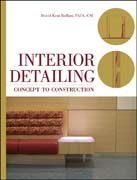
Interior Detailing provides interior designers and architects with a unique collection of interior details and material information; connecting the realms of design technical detailing that are typically treated separately. The book,which includes 150 easy to understand details, shows how to logically think through the design and development of an assembly so it conforms to the designer's intent and meets practical requirements of good construction INDICE: List of Tables. List of Illustrations. Preface. Acknowledgments. Introduction. How SI units are used in this book. Part 1 Roadmap to solving detailing problems. Chapter 1 The design/detailing process. Introduction. What isdetailing. Detailing as a wicked problem. The drawing-thinking-drawing cycle.Process tools and techniques. Process tools. Practical tips. Detailing components and process. The four aspects of detailing. The detailing process. Example. Three purposes of a detail. Contributes to design concept--elements and principles of design. Resolves problems of connection or transition. Coordinates with adjacent construction. Programmatic concepts vs. design concepts. Chapter2 Constraints. Introduction. Substrates and adjacent construction. Substrate material. Substrate condition. Substrate size and position. Substrate space. Regulatory requirements. Fire tests for finish materials. Fire tests for construction materials. Budget. Time. Climate. Local labor conditions and trade practices. Industry standards. Materials. Aesthetic qualities. Function. Safety and health. Durability. Maintainability. Cost and delivery time. Chapter 3 Function. Concealment and finish. Covering substrates. Covering joints and connections. Hiding mechanical, electrical and other services. Human fit/object fit. Safety: protection from accidental harm. Security: protection from intentional harm. Sustainability. Change and Relocatability. Fire resistance. Acoustic control. Noise control and reverberation. Transmission control. Vibration and impact noise control. Moisture/water resistance. Chapter 4 Constructibility. Introduction. Structural requirements. Basic concepts of structure. Use simple direct bearing connections whenever possible. Incorporate beam action. Use the simplest connections possible. Use redundant connections or bearing when required. Use structural connections approved by the manufacturer. Use removable connections for reuse potential. Connections. Use the appropriate method for rigidconnections. Determine moveable connection type based on use. Minimize numberand types of connections. Make connections accessible. Movement. Use acclimated materials. Use relieved backs on wood. Use control joints. Provide expansion joints. Use sliding/overlapping joints. Use slip joints. Use building expansion joints. Provide clear space. Tolerances. Provide shim space. Provide scribe. Use reveals. Use offsets. Use filler strips. Use sliding or overlapping joints. Use adjustable connections. Give adequate clearance and incorporate intermediate attachments. Clearances. Allow space for working and assembly. Providespace for installation of pieces. Allow for tolerances. Durability. Self-durable. Applied protection. Maintainability. Cleanability. Adjustability. Repair and replacement. Construction process. Number of parts. Sequence. Trade division of labor. Off-shelf vs. Custom parts. Shop vs. field-fabricated. Part 2 Elements. Chapter 5 Dividing space--permanent. Introduction. Element concepts. Function. Constraints. Coordination. Methods. Planar. Panelized. Barriers with openings. Translucent. Partial height. Chapter 6 Dividing and creating space with temporary barriers. Introduction. Element concepts. Function. Constraints. Coordination. Methods. Full height. Partial height. Chapter 7 Overhead limits--ceilings. Introduction. Element concepts. Function. Constraints. Coordination. Sprinkler spacing. HVAC coordination. Tolerance coordination. Methods. Closed. Open. Chapter 8 The ground plane--floors, stairs, and ramps. Introduction. Element concepts. Flooring. Stairs. Ramps. Function. Constraints. Fire resistance of floor finishes. Fire resistance of structural components. Slip resistance and tripping. Accessibility. Code requirements. Coordination. Tolerance coordination. Light reflectance and acoustic coordination. Methods. Flooring. Handrails, guards, and stairways. Chapter 9 Spatial connection--openings, doors, and glazing. Introduction. Element concepts. Openings. Doors. Glazing. Window coverings. Function. Constraints. Coordination. Methods. Doors. Glazed openings. Window coverings. Part 3 Transitions. Chapter 10 Wall transitions. Introduction. Connections of major elements. Wall to floor. Standard bases. Featured bases. Component bases. Wall to ceiling. Standard ceiling transitions. Structural transitions. Planar transitions. Chapter 11 Planar transitions. Partition to Partition. In-plane transitions. Plain offsets. Interrupted offsets. Floor to floor. In-plane transitions. Plain offset floors. Interrupted offset. Ceiling to ceiling. In-plane transitions. Offset transitions. Chapter 12 Structural transitions. Introduction. Columns. Column to ceiling transitions. Column to floor transitions. Column to beam transitions. Beams. Beam to partition transitions. Beam to ceiling transitions. Beam to beam transitions. Suspended objects. Appendix A Resources. Appendix B Industry standards for interior materials and products. Index.
- ISBN: 978-0-470-50497-0
- Editorial: John Wiley & Sons
- Encuadernacion: Cartoné
- Páginas: 304
- Fecha Publicación: 06/10/2010
- Nº Volúmenes: 1
- Idioma: Inglés
